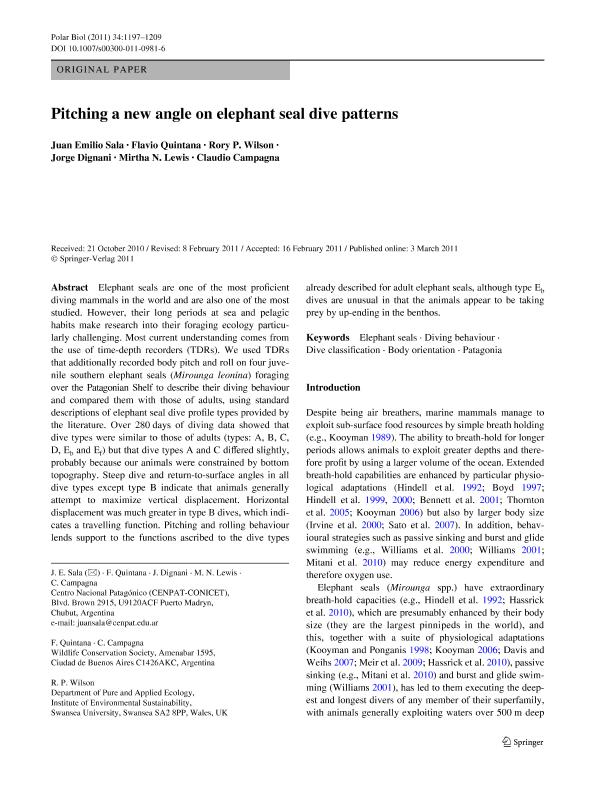Mostrar el registro sencillo del ítem
dc.contributor.author
Sala, Juan Emilio

dc.contributor.author
Quintana, Flavio Roberto

dc.contributor.author
Wilson, Rory P.

dc.contributor.author
Dignani, Jorge Pablo

dc.contributor.author
Lewis, Mirtha Noemi

dc.contributor.author
Campagna, Claudio

dc.date.available
2019-10-02T18:19:04Z
dc.date.issued
2011-08
dc.identifier.citation
Sala, Juan Emilio; Quintana, Flavio Roberto; Wilson, Rory P.; Dignani, Jorge Pablo; Lewis, Mirtha Noemi; et al.; Pitching a new angle on elephant seal dive patterns; Springer; Polar Biology; 34; 8; 8-2011; 1197-1209
dc.identifier.issn
0722-4060
dc.identifier.uri
http://hdl.handle.net/11336/85046
dc.description.abstract
Elephant seals are one of the most proficient diving mammals in the world and are also one of the most studied. However, their long periods at sea and pelagic habits make research into their foraging ecology particularly challenging. Most current understanding comes from the use of time-depth recorders (TDRs). We used TDRs that additionally recorded body pitch and roll on four juvenile southern elephant seals (Mirounga leonina) foraging over the Patagonian Shelf to describe their diving behaviour and compared them with those of adults, using standard descriptions of elephant seal dive profile types provided by the literature. Over 280 days of diving data showed that dive types were similar to those of adults (types: A, B, C, D, Eb and Ef) but that dive types A and C differed slightly, probably because our animals were constrained by bottom topography. Steep dive and return-to-surface angles in all dive types except type B indicate that animals generally attempt to maximize vertical displacement. Horizontal displacement was much greater in type B dives, which indicates a travelling function. Pitching and rolling behaviour lends support to the functions ascribed to the dive types already described for adult elephant seals, although type Eb dives are unusual in that the animals appear to be taking prey by up-ending in the benthos.
dc.format
application/pdf
dc.language.iso
eng
dc.publisher
Springer

dc.rights
info:eu-repo/semantics/openAccess
dc.rights.uri
https://creativecommons.org/licenses/by-nc-sa/2.5/ar/
dc.subject
BODY ORIENTATION
dc.subject
DIVE CLASSIFICATION
dc.subject
DIVING BEHAVIOUR
dc.subject
ELEPHANT SEALS
dc.subject
PATAGONIA
dc.subject.classification
Zoología, Ornitología, Entomología, Etología

dc.subject.classification
Ciencias Biológicas

dc.subject.classification
CIENCIAS NATURALES Y EXACTAS

dc.subject.classification
Ecología

dc.subject.classification
Ciencias Biológicas

dc.subject.classification
CIENCIAS NATURALES Y EXACTAS

dc.subject.classification
Biología Marina, Limnología

dc.subject.classification
Ciencias Biológicas

dc.subject.classification
CIENCIAS NATURALES Y EXACTAS

dc.title
Pitching a new angle on elephant seal dive patterns
dc.type
info:eu-repo/semantics/article
dc.type
info:ar-repo/semantics/artículo
dc.type
info:eu-repo/semantics/publishedVersion
dc.date.updated
2019-09-20T15:10:41Z
dc.identifier.eissn
1432-2056
dc.journal.volume
34
dc.journal.number
8
dc.journal.pagination
1197-1209
dc.journal.pais
Alemania

dc.journal.ciudad
Berlin
dc.description.fil
Fil: Sala, Juan Emilio. Consejo Nacional de Investigaciones Científicas y Técnicas. Centro Nacional Patagónico; Argentina
dc.description.fil
Fil: Quintana, Flavio Roberto. Consejo Nacional de Investigaciones Científicas y Técnicas. Centro Nacional Patagónico; Argentina. Wildlife Conservation Society; Estados Unidos
dc.description.fil
Fil: Wilson, Rory P.. Swansea University; Reino Unido
dc.description.fil
Fil: Dignani, Jorge Pablo. Consejo Nacional de Investigaciones Científicas y Técnicas. Centro Nacional Patagónico; Argentina
dc.description.fil
Fil: Lewis, Mirtha Noemi. Consejo Nacional de Investigaciones Científicas y Técnicas. Centro Nacional Patagónico; Argentina
dc.description.fil
Fil: Campagna, Claudio. Consejo Nacional de Investigaciones Científicas y Técnicas. Centro Nacional Patagónico; Argentina. Wildlife Conservation Society; Estados Unidos
dc.journal.title
Polar Biology

dc.relation.alternativeid
info:eu-repo/semantics/altIdentifier/doi/http://dx.doi.org/10.1007/s00300-011-0981-6
dc.relation.alternativeid
info:eu-repo/semantics/altIdentifier/url/https://link.springer.com/article/10.1007%2Fs00300-011-0981-6
Archivos asociados
